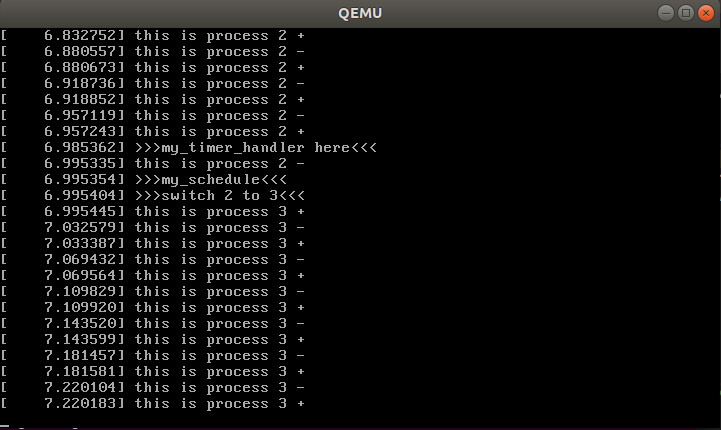基于mykernel 2.0编写一个操作系统内核
配置mykernel2.0,熟悉Linux内核的编译
在terminal中逐条输入以下命令:
wget https://raw.github.com/mengning/mykernel/master/mykernel-2.0_for_linux-5.4.34.patch sudo apt install axel axel -n 20 https://mirrors.edge.kernel.org/pub/linux/kernel/v5.x/linux-5.4.34.tar.xz xz -d linux-5.4.34.tar.xz tar -xvf linux-5.4.34.tar cd linux-5.4.34 patch -p1 < ../mykernel-2.0_for_linux-5.4.34.patch sudo apt install build-essential libncurses-dev bison flex libssl-dev libelf-dev make defconfig # Default configuration is based on 'x86_64_defconfig' # 使用allnoconfig编译出来qemu无法加载启动,不知道为什么? make -j$(nproc) # 编译的时间比较久哦 sudo apt install qemu # install QEMU qemu-system-x86_64 -kernel arch/x86/boot/bzImage
即可完成mykernel2.0的下载、配置和编译。
其中, make -j$(nproc) 命令是编译内核,nproc是一个内核参数,指系统最大进程数,$(nproc)获取系统该参数,完成内核编译。
基于mykernel 2.0编写一个操作系统内核
1. 定义进程结构体
在mykernel目录下新建mypcb.h头文件,用于定义进程控制块PCB,在Linux内核中,实际上是struct task_struct结构体。
#define MAX_TASK_NUM 4
#define KERNEL_STACK_SIZE 1024*2
/* CPU-specific state of this task */
struct Thread {
unsigned long ip;
unsigned long sp;
};
typedef struct PCB{
int pid; //进程号
volatile long state; // -1阻塞态 0就绪态 >0停止执行
unsigned long stack[KERNEL_STACK_SIZE]; //当前进程栈空间
/* CPU-specific state of this task */
struct Thread thread; //当前线程
unsigned long task_entry; //进程入口地址
struct PCB *next; //指向下一个进程的PCB
}tPCB;
void my_schedule(void);
2. 模拟进程运行
对mymain.c进行修改,这里是mykernel内核代码的入口,在my_start_kernel中对内核各个部分进行初始化。
首先是初始化0号进程,然后对1~MAX_TASK_NUM号进程进行初始化,所以进程的state初始化为0,即就绪态,可以运行。
所有进程组成一个循环链表,即最后一个tPCB的next指向首个tPCB。
添加my_process函数,模拟进程执行的过程。my_need_sched表示是否需要进程调度,值为1时调用my_schedule函数进行进程切换。
void __init my_start_kernel(void)
{
int pid = 0;
int i;
//初始化0号进程
task[pid].pid = pid;
task[pid].state = 0;
task[pid].task_entry = task[pid].thread.ip = (unsigned long)my_process;
task[pid].thread.sp = (unsigned long)&task[pid].stack[KERNEL_STACK_SIZE - 1];
task[pid].next = &task[pid];
//创建后续进程
for (i = 1; i < MAX_TASK_NUM;++i){
memcpy(&task[i], &task[0], sizeof(tPCB));
task[pid].pid = i;
task[pid].state = 0;
task[pid].thread.sp = (unsigned long)&task[i].stack[KERNEL_STACK_SIZE - 1];
task[i].next = task[i - 1].next;
task[i - 1].next = &task[i];
}
//进入0号进程
pid = 0;
my_current_task = &task[pid];
asm volatile(
"movq %1,%%rsp\n\t" /* set task[pid].thread.sp to rsp */
"pushq %1\n\t" /* push rbp */
"pushq %0\n\t" /* push task[pid].thread.ip */
"ret\n\t" /* pop task[pid].thread.ip to rip */
:
: "c" (task[pid].thread.ip),"d" (task[pid].thread.sp) /* input c or d mean %ecx/%edx*/
);
}
void my_process(void){
int i = 0;
while(1){
++i;
if(i % 10000000 == 0){
printk(KERN_NOTICE "this is process %d -\n", my_current_task->pid);
if (my_need_sched == 1) /*1表示需要切换到下一个进程,0表示不需要*/
{
my_need_sched = 0; /*重新置0,执行一个时间片*/
my_schedule(); /*切换进程*/
}
printk(KERN_NOTICE "this is process %d +\n", my_current_task->pid);
}
}
}
3. 进程调度和切换
修改myinterrupt.c中的my_timer_handler用于记录时间片,同时增加my_schedule函数用于进程切换。
void my_timer_handler(void)
{
if(time_count % 1000 == 0 && my_need_sched == 0){
printk(KERN_NOTICE ">>>my_timer_handler here<<<\n");
my_need_sched = 1;
}
++time_count;
return;
}
void my_schedule(void){
tPCB *next;
tPCB *prev;
if(my_current_task == NULL || my_current_task->next == NULL){
return;
}
printk(KERN_NOTICE ">>>my_schedule<<<\n");
next = my_current_task->next;
prev = my_current_task;
if(next->state == 0){
my_current_task = next;
printk(KERN_NOTICE ">>>switch %d to %d<<<\n",prev->pid,next->pid);/* 切换进程 */
asm volatile(
"pushq %%rbp\n\t"
"movq %%rsp,%0\n\t"
"movq %2,%%rsp\n\t"
"movq $1f,%1\n\t"
"pushq %3\n\t"
"ret\n\t"
"1:\t"
"popq %%rbp\n\t"
: "=m" (prev->thread.sp),"=m" (prev->thread.ip)
: "m" (next->thread.sp),"m" (next->thread.ip)
);
}
return;
}
代码修改完成后,执行命令:diff -Naur linux-5.4.34 linux-5.4.34-mykernel > mykernel-2.0_for_linux-5.3.34.patch 生成补丁,并重新编译。
再次运行可以看到进程不断切换。

操作系统内核核心功能及运行工作机制
操作系统内核的核心功能之一是进程管理,包括对进程的创建和销毁、进程间通信以及实现进程间的切换和对CPU的共享实用。
以下通过进程切换代码分析其运行工作机制:
asm volatile(
"pushq %%rbp\n\t"
"movq %%rsp,%0\n\t"
"movq %2,%%rsp\n\t"
"movq $1f,%1\n\t"
"pushq %3\n\t"
"ret\n\t"
"1:\t"
"popq %%rbp\n\t"
: "=m" (prev->thread.sp),"=m" (prev->thread.ip)
: "m" (next->thread.sp),"m" (next->thread.ip)
);
1)"pushq %%rbp\n\t"
将RBP中的值压入堆栈中,完成对跳转前进程栈基地址的保存
2)"movq %%rsp,%0\n\t"
将RSP中的值存入thread.sp中,完成对跳转前进程RSP的保存
3)"movq %2,%%rsp\n\t"
将next.thread.sp的值传入RSP中,也就是RSP表示的栈顶指针指向下一个进程的内存区
4)"movq $1f,%1\n\t"
将$1f存入thread.ip中
5)"pushq %3\n\t"
将thread.ip的值($1f)压入栈中,因为要完成RIP的存储切换,但RIP不能随意更改,只能通过堆栈操作进行更改,所以使用这样的方法来保存
6)"ret\n\t"
pop next.thread的rip,执行next.thread也就是$1后面的语句
7)"popq %%rbp\n\t"
pop出的值存入RBP中,也就是RBP指向当前进程的栈底






 浙公网安备 33010602011771号
浙公网安备 33010602011771号